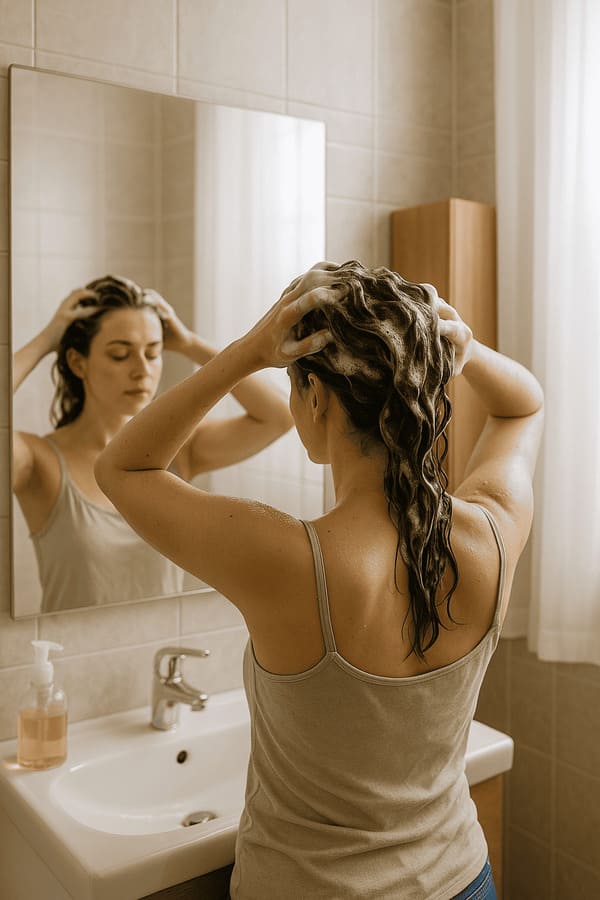Henna is the powder obtained from the dried leaves of a plant, Lawsonia Inermis , a thorny shrub that grows abundantly in areas of the world with hot, dry climates such as Africa, the Middle East and India.
Lawsonia Inermis contains a colouring pigment in its leaves, lawsone, which dyes it an intense orange-red.
Henna has been used since ancient times to color hair, dye fabrics and adorn the body with tattoos.
This natural dye not only colors but is also very rich in nourishing, protective and invigorating substances for the skin and hair.
Henna powder colors the hair by binding to the keratin , filling the hair scales which are also made fuller! It is therefore perfect for those with very thin, fragile hair or with split ends.
Pure henna colors thanks to its pigment content , namely lawsone molecules, and dyes only and exclusively red. By binding to keratin, the result obtained will be different based on the starting color.
But then what is black henna?
Index
What is black henna?
The term henna has expanded to include all those natural hair dyeing herbs .
The products defined as blonde henna, brown henna, black henna are called this way for convenience of language but in addition to pure henna they contain a mixture of dyeing herbs.
The black one will contain a percentage of Lawsonia inermis to which other herbs will be added.
We always recommend that you do some tests to see the result you can get on your hair.
The lawsone molecule, contained only in pure henna and with an orange-red color, is the only one able to bind to the keratin of the hair and make the coloring permanent. Based on the percentage contained, the henna will be more or less long-lasting, even if by nature it tends to fade with the passing of time.
Never use dye mixtures containing Indigo if you have bleached hair because you risk obtaining a color that tends towards green!
How to prepare
You can make a black herbal dye using Indigofera Tinctoria , also known as Indigo.
Indigo is a plant whose leaves contain a blue -toned dye molecule. Did you know that jeans are dyed with Indigo?
It is always recommended to mix it with Red Henna to fix the color to the hair and improve its hold over time.
In fact, red henna is the only dyeing herb that can bind to the hair's keratin, thus ensuring that the color stays on the hair for a long time .
If you prefer to avoid mixing the various herbs yourself to obtain the black, you can use one of the ready-made mixes available on the market, with herbs already mixed in the right proportions.
To prepare black henna, it is recommended not to use lemon, hibiscus, tea and various infusions but only water because they would bring out the warm and coppery tones.
The perfect water temperature is between 50° and 60° , to keep the colouring power intact and avoid excessively highlighting the copper/orange tones.
Does it cover grey hair?
To cover gray hair and get a black color there are various options.
If you have a few gray hairs, you can apply black henna directly to your natural base. Depending on the recipe you choose, the gray hair will remain lighter but will be able to blend well with the base;
If you have a lot of white hair, if your natural base is very light or if you have bleached your hair, you need to do a two-step coloring:
- in the first step only red henna to pigment the hair and create a uniform base
- at the second step indigo
In this case, you just need to prepare a first cold red henna, to be left on for at least 45-60 minutes, as always covered with a cap and towel to keep everything warm. Once this first application is finished, rinse with hot water, towel dry your hair well or dry it if you prefer and apply your black henna. If you are more comfortable, you can also do the second step the next day!
The double pass is not always necessary, there are hairs that are able to absorb the pigment better than others and have excellent results already with a single pass; later you can decide to do the double pass only on the regrowth touch-ups, so as to optimize and reduce the processing times!
Important: if your natural base is blonde, natural, dyed or bleached, it is necessary to do a first pass with pure red henna, to avoid having strange greenish shades.
The best natural black hennas
There are many ready-made black henna mixes on the market, to which you only need to add water to obtain the perfect consistency for application.
Natural, pure, picramate-free dyeing powders that allow you to obtain a smooth, soft paste that is extremely comfortable to use.
Here are some of our favorite black hennas!
Do you have questions about henna? Discover in this article all the most requested FAQs about henna !
Want to continue discovering the world of henna and natural dyes? Continue reading in our section dedicated to all the guides for henna and dyeing herbs .













